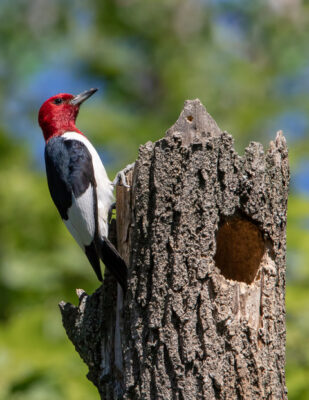In today’s post, Park Naturalist Nicole Guthrie discusses what makes a forest a forest, and the unique features of Pinery Provincial Park.
This week marks National Forest Week in Canada, making it the perfect time to discuss the astounding diversity of species and ecosystems in forests because there’s no such thing as “just a forest.”
Each forest has a unique combination of soil types, microclimates, and pollution levels, which all dictate which species can take up residence there.
If you’ve ever been to Pinery, you’ve likely enjoyed their beautiful forest.
But did you know it isn’t actually all forest?
A savanna in Ontario?
Pinery is largely composed of a rare oak savanna habitat.
Savannas are a type of treed ecosystem where there is 25% or less canopy cover (the amount of sky that is obscured by trees).
Canopy cover from 25-50% is considered a woodland, and anything more than 50% is considered a true forest.

In Pinery specifically, the dominant type of trees found are oaks, hence the name oak savanna. Seven species of oak that dominate the landscape.
What makes savannas so different? The floor of the “forest” is flooded with light during the day. This allows for plants to grow on the floor that would otherwise be unable to survive in a traditional forest.
Some of these plants include:
- New Jersey Tea (Ceanothus spp.)
- Woodland Sunflower (Helianthus spp.)
- Rough Blazing Star (Liatris aspera)
- Green Comet Milkweed (Asclepias viridiflora).
Here in the park, there are plenty of creatures that either love oaks, love an open canopy, or both!

One of these is the Red-headed Woodpecker, a species-at-risk listed as endangered in Ontario.
Part of the reason for their endangered status comes from a declining amount of habitat for them to live in, paired with a declining number of standing dead oaks (also known as snags) for them to forage on and nest in.
Dead trees can be just as valuable as living ones and they play an important role in our savannas and forests.
The Carolinas in Canada
Pinery also happens to be in a unique place because it is at the northern edge of Carolinian Canada.
This is an ecoregion found west of an imaginary line between Grand Bend (just outside of Pinery) and Toronto.

Carolinian Canada is the most biodiverse ecoregion in all of Canada, with an interesting mix of northern and southern species.
It’s named for the Carolinas in the United States, where many of the same archetypical species are abundant.
Typical Carolinian forests may have:
- Hickory (Carya spp.)
- Elm (Ulmus spp.)
- Ash (Fraxinus spp.)
- Walnut (Juglans spp.)
- Maple (Acer spp.)
- American Sycamore (Platanus occidentalis)
- Tulip Trees (Liriodendron tulipifera).Many of these species do not naturally occur further north than Pinery in Canada.
A small portion of Pinery is true Carolinian forest, found in the southwestern end of the park.

It can be best viewed from the Carolinian Trail.
Compared to the quick-draining sandy soil found throughout the park, the nearby Ausable River allows for more water retention in the soil here.
Over time, wet conditions lead to the build-up of nutrients in the soil. This allows Carolinian species to live where they otherwise wouldn’t elsewhere in Pinery.
Perhaps the best example of this is the Tulip Tree.
They are one of the tallest-growing species of tree in eastern North America. Known to grow up to 30 metres (or about 100 feet) tall, their trunks are remarkably straight and have beautifully ridged bark.
In the spring, they grow flowers that resemble tulip blooms, which is their namesake.

Given the extreme height of mature trees, the flowers are difficult to find, however in May, the flowers begin to fall and you can watch the petals dance their way to the forest floor.
Explore these unique landscapes!
National Forest Week is an incredible opportunity to gain a deeper appreciation for oak savannas, oak woodlands, and the Carolinian ecoregion.
On your next trip to the forest, look a little deeper, and you may be surprised by what you find!
